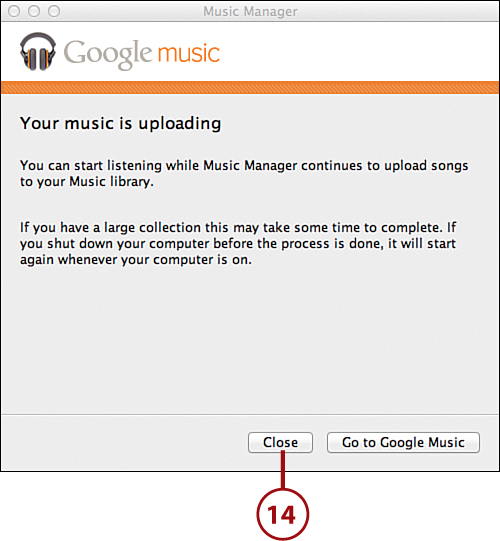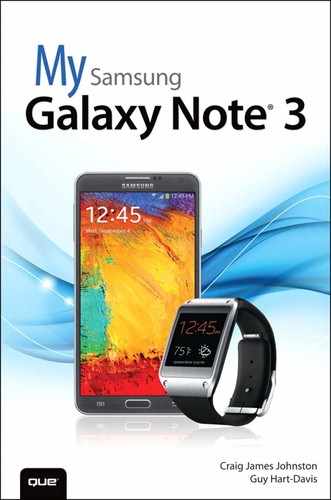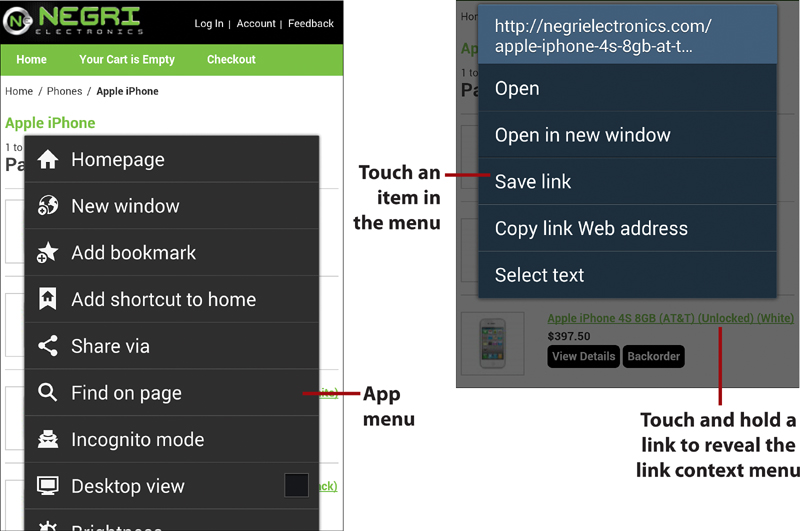Getting to Know Your Samsung Galaxy Note 3
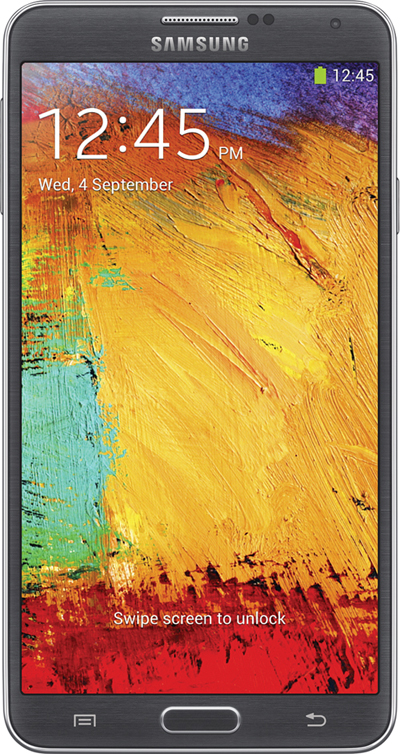
In this chapter, you become familiar with the external features of the Galaxy Note 3 and the basics of getting started with the Android operating system. Topics include the following:
→ Getting to know your Galaxy Note 3’s external features
→ Getting to know your Galaxy Note 3’s S Pen (Stylus)
→ Learning the fundamentals of Android 4.3 (Jelly Bean) and TouchWiz
→ Setting up your Galaxy Note 3 for the first time
→ Installing desktop synchronization software
Let’s start by getting to know more about your Galaxy Note 3 by examing the external features, device features, and how the Android 4.3 operating system works.
In addition to Android 4.3 (Jelly Bean), this chapter covers the Samsung TouchWiz interface, which is overlaid on top of Android to adjust the way things look and function.
Your Galaxy Note 3’s External Features
Becoming familiar with the external features of your Galaxy Note 3 is a good place to start because you will be using them often. This section covers some of the technical specifications of your Galaxy Note 3, including the touchscreen, camera, and S Pen. There are many versions of the Samsung Galaxy Note 3, but no matter which one you own or which wireless carrier you use to connect it, the exterior, functionality, and look and feel of the interface is exactly the same.
Front

• Proximity sensor—Detects when you place your Galaxy Note 3 against your head to talk, which causes it to turn off the screen so that your ear doesn’t inadvertently activate things on the screen.
• Light sensor—Adjusts the brightness of your Galaxy Note 3’s screen based on the brightness of the ambient light.
• Earpiece—The part you hold against your ear while on a call.
• Indicator light—Indicates new events (such as missed calls, new Facebook messages, or new emails).
• Front camera—2.0-megapixel front-facing camera that you use for video chat, taking self-portraits, and even unlocking your Galaxy Note 3 using your face.
• Touchscreen—The Galaxy Note 3 has a 5.7" 1080×1920-pixel Full HD Super AMOLED HD (Super Active-Matrix Organic Light-Emitting Diode) screen that incorporates capacitive touch.
• Back button—Touch to go back one screen when using an application or menu. This is a touch-sensitive button.
• Menu button—Touch to see a context-aware menu of options based on the screen or app you are using.
• Home button—Press to go to the Home screen. The application that you are using continues to run in the background. Press and hold to see a list of recently used apps and switch between them. This is a physical button.
Back

• Volume up/down buttons—Enables you to control the audio volume on calls and while playing audio and video.
• Power button—Allows you to wake up your Galaxy Note 3 by pressing once. Press and hold for one second to reveal a menu of choices. The choices enable you to put your Galaxy Note 3 into Silent mode, Airplane mode, or power it off completely.
• Rear camera—13-megapixel camera with autofocus that takes clear pictures close-up or far away.
• LED (light-emitting diode) camera flash—Helps to illuminate the surroundings when taking pictures in low light.
• Back cover removal point—Allows you to remove the back cover. Insert your fingernail and pull to remove the back cover. After you have removed the back cover, you can install or swap SIM cards, and insert or swap the Micro-SD memory card.
Top
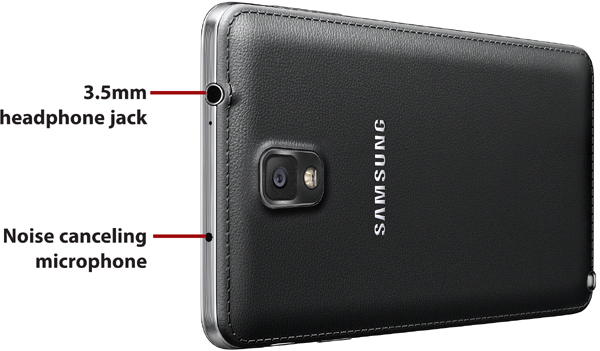
• 3.5mm headphone jack—Plug in your Galaxy Note 3 or third-party headsets to enjoy music and talk on the phone.
• Noise canceling microphone—Use in conjuction with the regular microphone on phone calls to reduce background noise. This microphone is also used when you record videos.
Bottom

• MHL 2.0-compliant Micro-USB 3 port—You can use the Micro-USB 3 port to synchronize your Galaxy Note 3 to your desktop computer and charge it, but because it is Mobile High-definition Link (MHL) compliant, you can use it to play movies on your TV via high-definition multimedia interface (HDMI) using a special cable or dock.
• Speaker—Produces audio when you use the speakerphone or when you play audio.
• Microphone—You use the microphone when you are on a call and holding your Galaxy Note 3 to your ear.
• S Pen (Stylus)—Pull the S Pen out of its holder to draw on the screen and interact with apps. Read more about the S Pen in the next section.
S Pen
Your Samsung Galaxy Note 3 comes with a stylus, which Samsung calls the S Pen. The S Pen is stored in the Galaxy Note 3 on the right side and you pull it out from the lower right. This section covers some of the S Pen’s features and functions.

• Stylus tip—The S Pen stylus tip is what makes contact with the screen as you write and draw. The stylus tip is pressure sensitive so it knows how hard or soft you are pressing. This is particularly useful for drawing as pressure translates into line thickness.
• S Pen button—The S Pen button adds extra functionality to the S Pen. When you press the button as you drag the pen on the screen, you can perform functions, such as moving between screens, taking screenshots, and even cutting out parts of any screen.
Air Command
When you remove your S Pen, Air Command is the first thing that pops up. Air Command gives you quick access to useful S Pen functionality.
• Action Memo—Write in a special note area and tell your Note 3 to take action on what you write. For example, write a phone number and tell Action Memo to dial that number.
• Scrap Booker—Capture a part of the screen by drawing around the area you want to capture. The captured images are saved to the Scrapbook app.
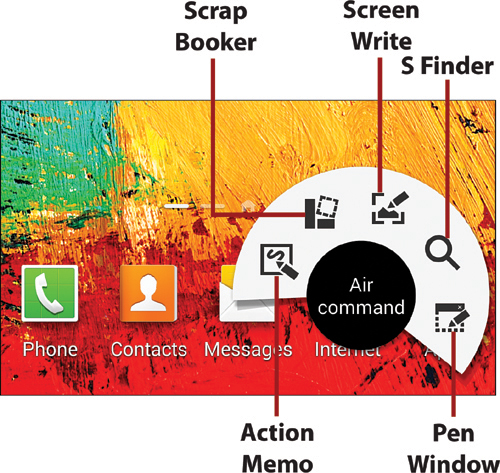
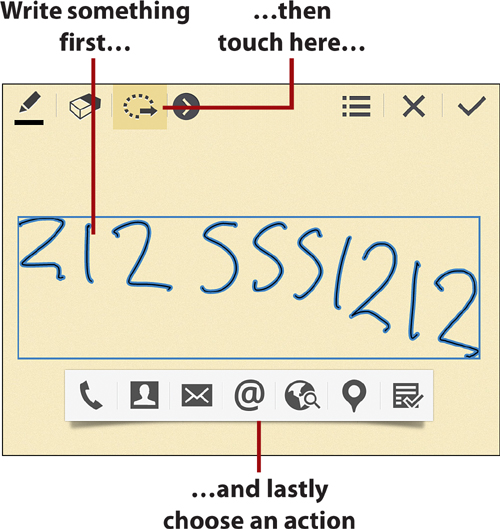

• Screen Write—Capture the entire screen and then write on the image of the captured screen. Your image is saved in the Gallery app in the Screenshots album.
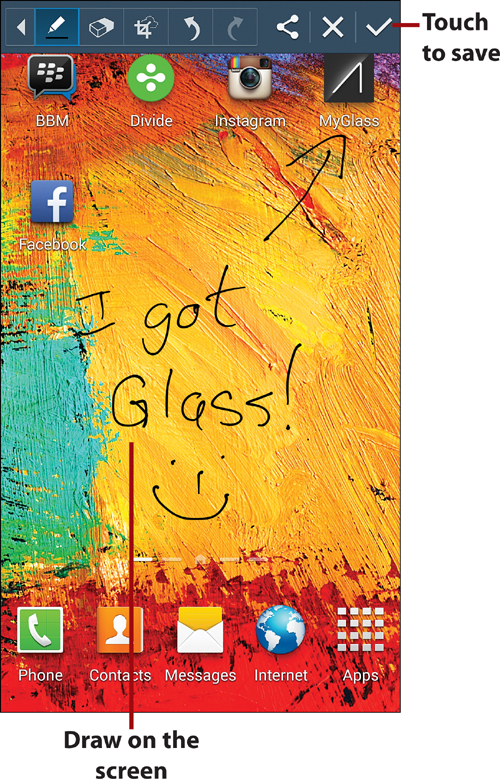

• S Finder—Allows you to search your Note 3 for apps and other content, plus search the Internet.
• Pen Window—Allows you to draw a box of any size on the screen. You see a box with some app choices. Selecting an app launches it in a small window over whatever you are doing. You can use the app like you normally do even while it’s in the small window.
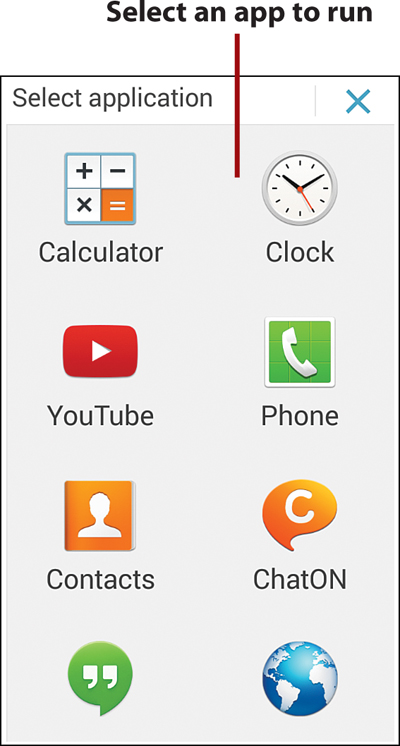

Air View
Air View is a feature that shows you a preview of information about an object and enables you to interact with it when you hover the S Pen or finger near the screen over an object that is Air View enabled. Make sure that Air View is turned on in Settings before you try to use it. Please refer to Chapter 2, “Customizing Your Galaxy Note 3,” to see how to turn on Air View and customize how it works. This section shows you some examples of using Air View.


Gestures
While holding the S Pen button, you can draw symbols on the screen to take actions such as going back to the previous screen or bringing up the menu. Here are some examples.

Scrolling Using the S Pen
You can scroll up and down by hovering your S Pen at the top or bottom of an area of the screen that scrolls, such as a message list. For this gesture, you must not press the S Pen button—just hover at the top or bottom of the scroll area. You see an arrow indicating that the scrolling gesture has been recognized.

First-Time Setup
Before setting up your new Samsung Galaxy Note 3, you should have a Google account because your Galaxy Note 3 running Android is tightly integrated into Google. When you have a Google account, you can store your content in the Google cloud, including any books and music you buy or movies you rent. If you do not already have a Google account, go to https://accounts.google.com on your desktop computer and sign up for one.
1. Touch and hold the Power button until you see the animation start playing.
2. Touch to change your language if needed.
3. Touch Next.
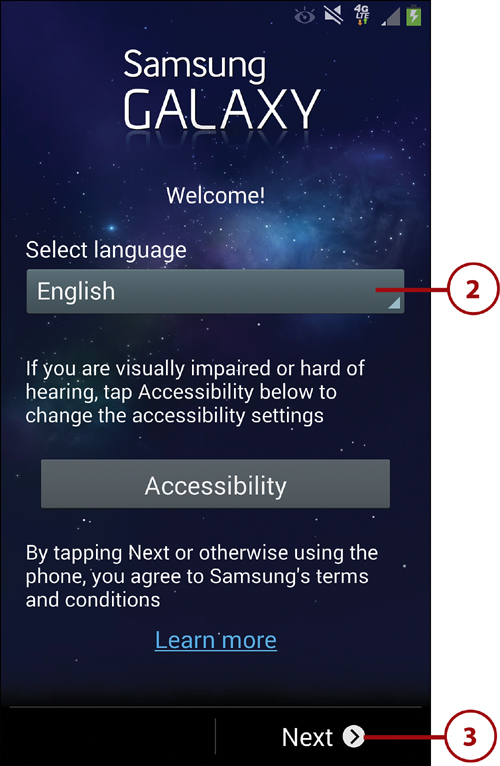
4. Touch a Wi-Fi network to connect. If you’d rather not connect to a Wi-Fi network, touch Next and continue at step 8.
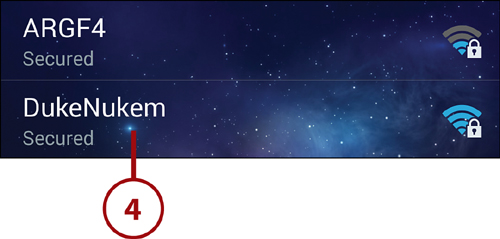

5. Enter the password for the Wi-Fi network using the onscreen keyboard.
6. Touch Connect. Your Galaxy Note 3 connects to the Wi-Fi network.

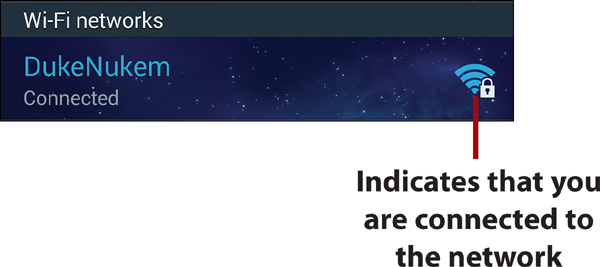
7. Touch Next.

8. Touch to sign in to your Samsung account, if you have one, or touch Skip and jump to step 17.
9. Touch to create a new Samsung account, if you don’t have one, or touch Skip and jump to step 17.

10. Enter the email address you used for your Samsung account.
11. Enter your Samsung account password.
12. Touch Sign In.
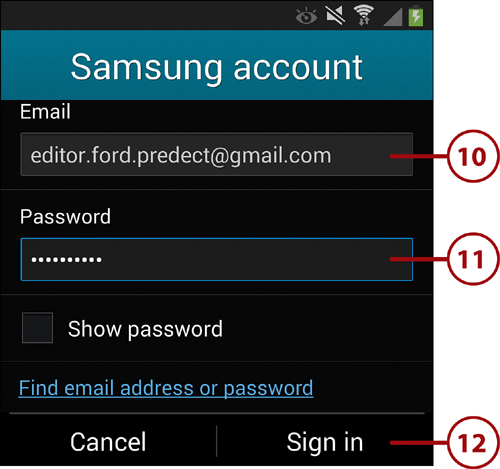
13. Touch to enable automatically backing up your data to your Samsung account.
14. Touch to first restore data previously backed up in the Samsung cloud to your Galaxy Note 3 before continuing.
15. Touch Next.

16. Touch Yes to log in to your Google account.
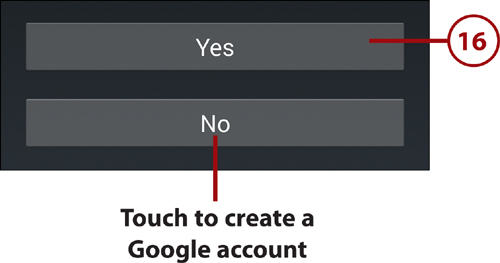
17. Enter your Google account email address (your Gmail address).
18. Enter your Google account password.
19. Touch to continue.
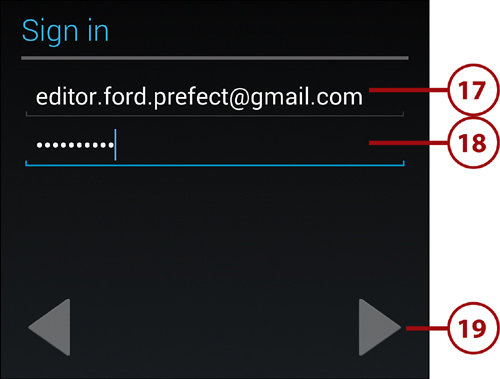
20. Check this box to restore settings previously saved in the Google cloud to your new Galaxy Note 3 before continuing.
21. Check this box to keep data on your Galaxy Note 3 backed up to the Google cloud.
22. Check this box if you are okay with Google collecting information about your geographic location at any time. Although this information is kept safe, if you are concerned about privacy rights, uncheck this box.
23. Check this box if you are okay with Google using your geographic location for Google searches and other Google services.
24. Touch to continue.
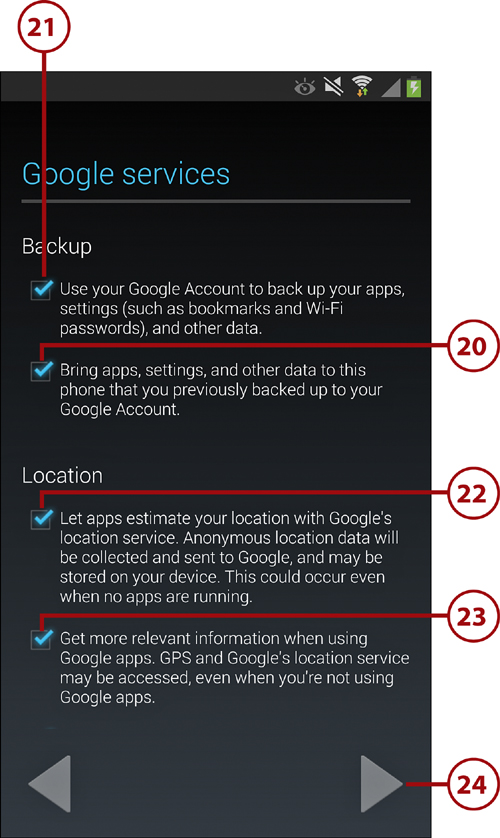
25. Touch to create a Dropbox account.
26. Touch to sign in to your existing Dropbox account.
27. Touch to skip using Dropbox and continue. If you choose to skip Dropbox, jump to step 31 to continue.

Do I Need Dropbox?
Dropbox is a company that provides cloud storage data. This means that you can use its storage to store your pictures, videos, and other files privately, and choose to share some of that content with your friends. You do not need to use Dropbox on your Galaxy Note 3. You can choose other cloud storage companies like Box.net, and even Google’s cloud storage.
28. Touch to choose whether to upload your camera photos when connected to only Wi-Fi, or anytime over Wi-Fi or cellular data.
What Is Camera Upload?
The Camera Upload feature lets your Note 3 upload all photos taken on your Note 3 camera into your Dropbox account automatically. In step 28 you choose when the photos are uploaded—when you’re connected to either a Wi-Fi or cellular network, or only when you’re connected to a Wi-Fi network.
29. Touch to enable Camera Upload.
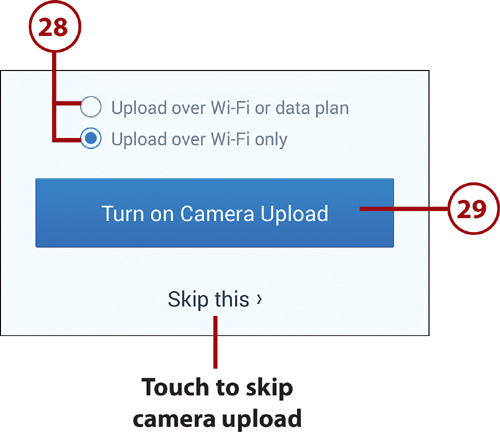
30. Touch to allow Samsung access to your Dropbox files and folders.
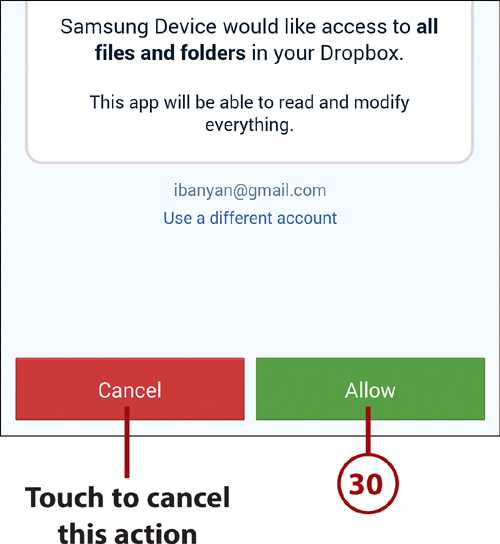
31. Enter a name for your Note 3. This name is used whenever you are connecting to other devices.

32. Touch Finish.

Fundamentals of Android 4.3 and TouchWiz
Your Galaxy Note 3 is run by an operating system called Android. Android was created by Google to run on any smartphone, and your Galaxy Note 3 uses a version called Android 4.3 (or Jelly Bean). Samsung has made many changes to this version of Android by adding extra components and modifying many standard Android features. They call this customization TouchWiz.
The Lock Screen
If you haven’t used your Galaxy Note 3 for a while, the screen goes blank to conserve battery power. This task explains how to interact with the Lock screen.
1. Press the Power button or Home button to wake up your Galaxy Note 3.
2. Slide your finger across the screen in any direction to unlock your Galaxy Note 3.
3. Touch the Missed Call notification and then swipe the screen to unlock and go directly to the call log.
4. Touch the Missed Text Message notification and then swipe the screen to unlock and go directly to the missed text message.

Working with Notifications and Settings on the Lock Screen
You can work with notifications and settings right on the Lock screen. If you see notifications in the Notification bar, pull down the Notification bar to view and clear them. Touching a notification takes you straight to the app that created them. Read more about the Notification bar later in this section.
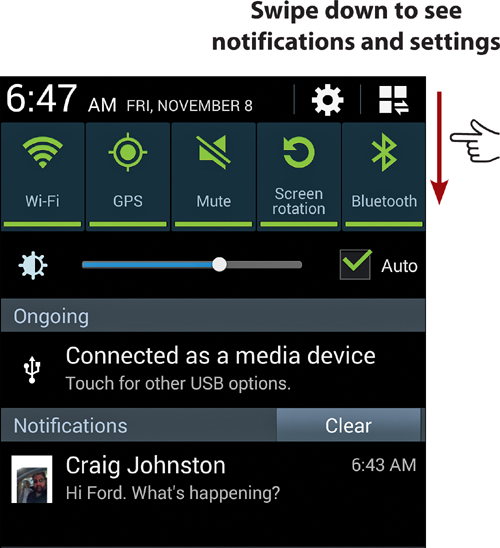
Answering a Call from the Lock Screen
If your Galaxy Note 3 is locked when a call comes in, you have three choices: Drag the green icon to answer the incoming call; drag the red icon to reject the incoming call and send it straight to voice mail; or drag up from the bottom of the screen to reject the call and send a preset text message (SMS) to the caller.

The Home Screen(s)
After you unlock your Galaxy Note 3, you are presented with the middle Home screen page. Your Galaxy Note 3 has five Home screen pages (although you can create more). The Home screen pages contain application shortcuts, a Launcher icon, Notification bar, Shortcuts, Favorites Tray, and widgets.

• Notification bar—The Notification bar shows information about Bluetooth, Wi-Fi, and cellular coverage, as well as the battery level and time. The Notification bar also serves as a place where apps can alert or notify you using notification icons.
• Notification icons—Notification icons appear in the Notification bar when an app needs to alert or notify you of something. For example, the Phone app can show the Missed Calls icon indicating that you missed a call.
• Widgets—Widgets are applications that run directly on the Home screens. They are specially designed to provide functionality and real-time information. An example of a widget is one that shows the current weather or provides a search capability. Widgets can be moved and sometimes resized.
• App shortcut—When you touch an app shortcut, the associated app launches.
• App folders—You can group apps together in a folder as a way to organize your apps and declutter your screen.
• Favorites Tray—The Favorites Tray is visible on all Home screen pages. You can drag apps to the Favorites Tray so that they are available no matter which Home screen you are looking at. Apps in the Favorites Tray can be rearranged and removed.
• Launcher icon—Touch to show application icons for all applications that you have installed on your Galaxy Note 3.
Work with Notifications
To interact with notifications that appear in the Notification bar, place your finger above the top of the screen and drag to pull down the Notification bar and reveal the notifications. Swipe individual notifications off the screen to the left or right to clear them one by one, or touch Clear to clear all of them at once. The Notification bar also includes Quick Settings such as the ability to turn on or off Wi-Fi or Bluetooth.

Create App Shortcuts
Touch the Launcher icon to see all of your apps. Touch and hold on the app you want to make a shortcut for. After the Home screens appear, drag the app shortcut to the location you want the shortcut to be on the Home screen, drag it to an App folder, or drag it left or right off the screen to move between Home screen pages. Release the icon to place it.


Create App Folders
To create a new App folder, touch and hold the first app shortcut you want in your folder. When the Create Folder icon appears, drag the app shortcut to that icon and release it. After you give your App folder a name, the folder displays on your Home screen. Now you can drag other app shortcuts into that folder. To open the folder, touch it to reveal the shortcuts in that folder.

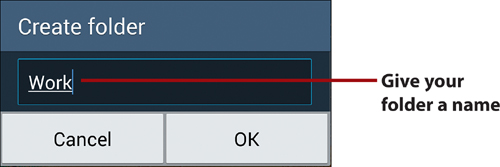

Creating a New Home Screen Page and Removing an App Shortcut
If you want to create a new Home screen page, touch and hold an app shortcut icon. Drag your app shortcut icon to the Create Page icon, and the shortcut is placed on a brand-new Home screen page. To remove an app shortcut icon, drag it to the Remove icon.

Use the Touchscreen
You interact with your Galaxy Note 3 mostly by touching the screen, which is known as making gestures on the screen. You can touch, swipe, pinch, double-tap, and type.
![]()
• Touch—To start an application, touch its icon. Touch a menu item to select it. Touch the letters of the onscreen keyboard to type.
![]()
• Touch and hold—Touch and hold to interact with an object. For example, if you touch and hold a blank area of the Home screen, a menu pops up. If you touch and hold an icon, you can reposition it with your finger.

• Drag—Dragging always starts with a touch and hold. For example, if you touch the Notification bar, you can drag it down to read all of the notification messages.

• Swipe or slide—Swipe or slide the screen to scroll quickly. To swipe or slide, move your finger across the screen quickly. Be careful not to touch and hold before you swipe or you will reposition something. You can also swipe to clear notifications or close apps when viewing the recent apps.
![]()
• Double-tap—Double-tapping is like double-clicking a mouse on a desktop computer. Tap the screen twice in quick succession. For example, you can double-tap a web page to zoom in to part of that page.
![]()
• Pinch—To zoom in and out of images and pages, place your thumb and forefinger on the screen. Pinch them together to zoom out or spread them apart to zoom in (unpinching). Applications like Browser, Gallery, and Maps support pinching.

• Rotate the screen—If you rotate your Galaxy Note 3 from an upright position to being on its left or right side, the screen switches from Portrait view to Landscape view. Most applications honor the screen orientation. The Home screens and Launcher do not.
Use the Keyboard
Your Galaxy Note 3 has a virtual or onscreen keyboard for those times when you need to enter text. You might be a little wary of a keyboard that has no physical keys, but you will be pleasantly surprised at how well it works.
Some applications automatically show the keyboard when you need to enter text. If the keyboard does not appear, touch the area where you want to type and the keyboard slides up ready for use.
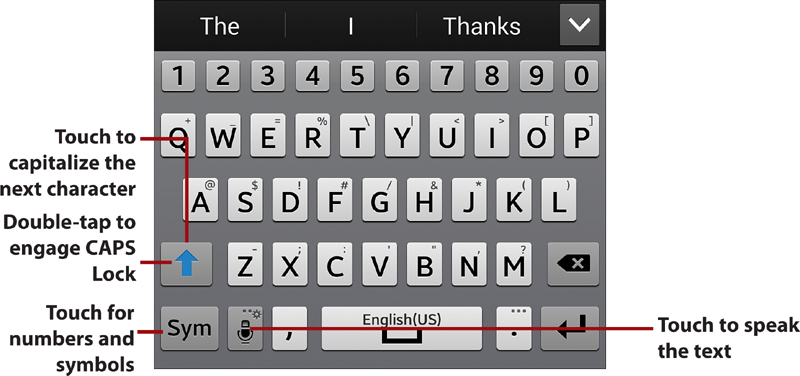
Using the virtual keyboard as you type, your Galaxy Note 3 makes word suggestions. Think of this as similar to the spell checker you would see in a word processor. Your Galaxy Note 3 uses a dictionary of words to guess what you are typing. If the word you were going to type is highlighted, touch space or period to select it. If you can see the word in the list but it is not highlighted, touch the word to select it.
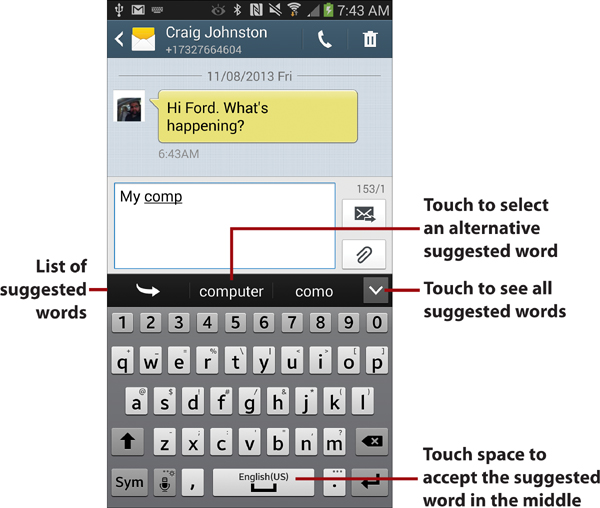
To make the next letter you type a capital letter, touch the Shift key. To make all letters capitals (or CAPS), double-tap the Shift key to engage CAPS Lock. Touch Shift again to disengage CAPS Lock.
To type numbers or symbols, touch the Symbols key.
When on the Numbers and Symbols screen, touch the Symbols key to see extra symbols. There are three screens of symbols. Touch the ABC key to return to the regular keyboard.

Quick Access to Symbols
If you want to type commonly used symbols, touch and hold the period key. A small window opens with those common symbols. Slide your finger over the symbol you want to type, and lift it to type that symbol.

To enter an accented character, touch and hold any vowel or C, N, or S keys. A small window opens enabling you to select an accented or alternative character. Slide your finger over the accented character and lift your finger to type it.
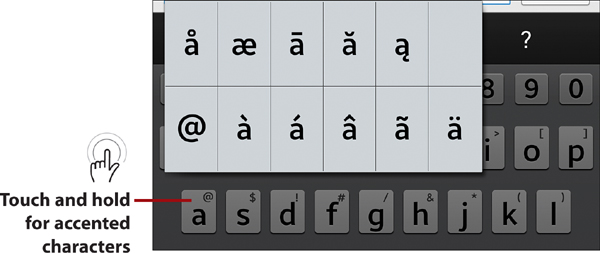
To reveal other alternative characters, touch and hold any other letter, number, or symbol.
Want a Larger Keyboard?
Turn your Galaxy Note 3 sideways to switch to a landscape keyboard. The landscape keyboard has larger keys and is easier to type on.

Instead of typing on the keyboard in the traditional way by touching each letter individually, you can swipe over the letters in one continuous movement. This is called Continuous Input. It is enabled by default; to use it, just start swiping your finger over the letters of the word you want to type. Lift your finger after each word. No need to worry about spaces because your Galaxy Note 3 adds them for you. To type a double letter (as in the word toll), loop around that letter on the keyboard.
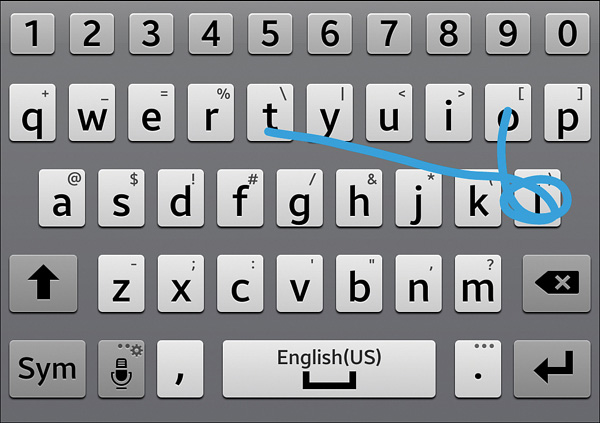
Dictation—Speak Instead of Type
Your Galaxy Note 3 can turn your voice into text. It uses Google’s speech recognition service, which means that you must have a connection to the cellular network or a Wi-Fi network to use it.
1. Touch the microphone key.

2. Wait until you see Speak Now and start speaking what you want to be typed. You can speak the punctuation by saying “comma,” “question mark,” “exclamation mark,” or “exclamation point.”
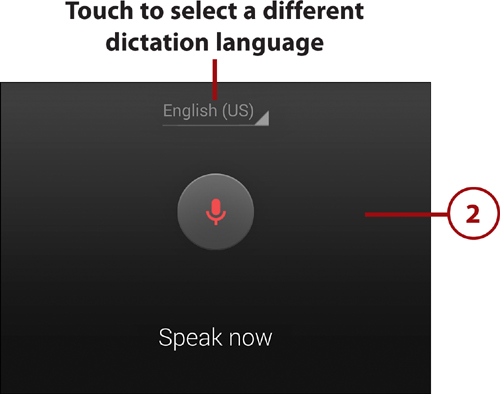
Edit Text
After you enter text, you can edit it by cutting, copying, or pasting the text. This task describes how to select and copy text so you can paste over a word with the copied text.
1. While you are typing, touch and hold a word you want to copy.

2. Slide the blue end markers until you have selected all of the text you want to copy.
3. Touch to copy the text.

4. Touch and hold the word you want to paste over.
5. Touch to paste what you copied earlier.

You can also simply place a cursor on the screen and move it around to do manual text editing, such as backspace to delete letters or manually insert a new word. To do this, tap the screen in the text area. A single blue marker displays; drag that marker to the point in the text you want to make changes to. Now start typing or tap backspace, and the action occurs at the cursor position.
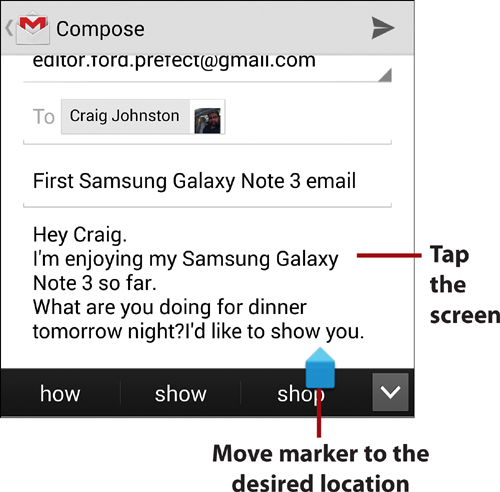
Writing Instead of Typing
As discussed earlier in this chapter, your Galaxy Note 3 comes with the S Pen stylus. Instead of typing on the keyboard, you can use handwriting recognition to write. To enable Handwriting mode, pull out the S Pen from its holder and touch the Back key to dismiss the Air Command window. Then hover the S Pen over the screen in the text area until you see the handwriting icon. Touch the icon with your S Pen. Any text you have typed appears to be in handwriting. Now write in your own handwriting on the screen and it is turned into text. Touch Done to return to typing.

Keyboard Tricks
You can write instead of typing, use emoticons (smiley faces), and enable a one-handed keyboard.
1. Touch and hold the microphone key (to the right of the Sym key).
2. Touch to see everything you have previously copied to the clipboard. If there is text, you can touch it to paste it at the cursor position.
3. Touch to change keyboard settings, including choosing a new keyboard.
4. Touch to type emoticons (smiley faces).
5. Touch to choose a one-handed keyboard.

Menus
Your Galaxy Note 3 has two types of menus: app menus and context menus. All applications use an app menu. To see the an app menu, touch the physical Menu button, which is to the left of the Home button.
A context menu applies to an item on the screen. If you touch and hold something on the screen (in this example, a link on a web page), a context menu appears. The items on the context menu differ based on the type of object you touched.
Switch Between Apps
You can switch between running apps and close apps using the multitasking feature.
1. Press and hold the Home button.
2. Scroll up and down the list of running apps.
3. Touch an app to switch to it.

4. Swipe an app left or right off the screen to close it.
Run Two Apps at the Same Time
Your Galaxy Note 3 has a feature called Multi Window that allows certain apps to run on the same screen at the same time.
Make Sure Multi Window Is Enabled
Before you start this section, make sure that Multi Window is enabled in the Quick Settings.

1. Touch the Multi Window handle to see apps.
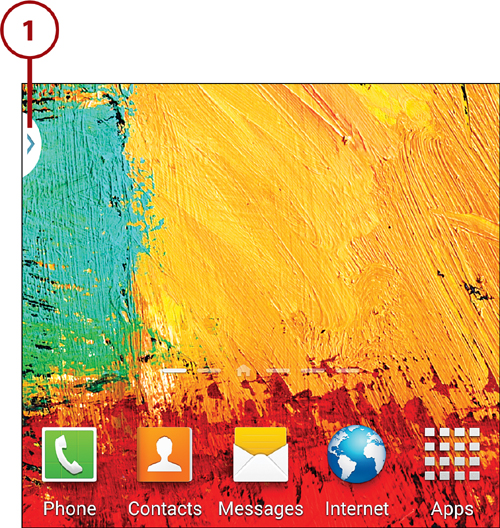
2. Drag an app onto the screen but keep holding it.
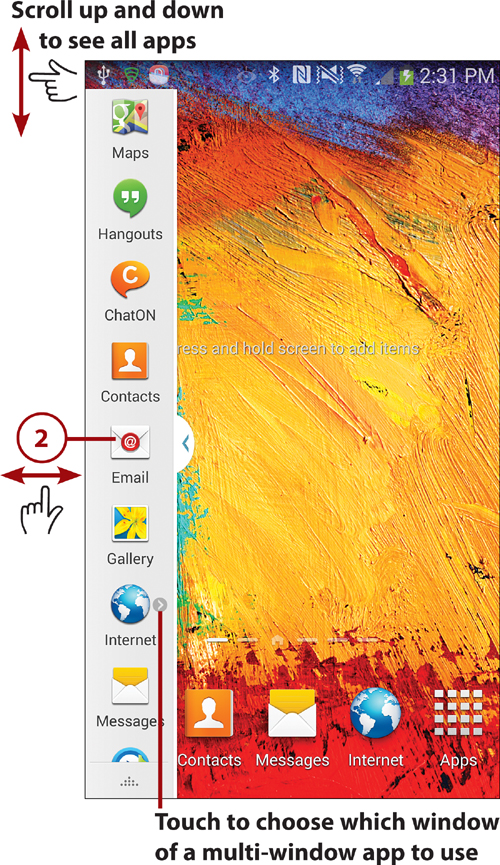
Not All Apps Support Multi Window
Apps must be specially written to take advantage of Multi Window mode. This means that you might not see the apps you are looking for until the developer updates the app to support Samsung’s Multi Window mode.
3. Drag the app to either the top or bottom half of the screen and release it. If this is the first app you are choosing then just release it anywhere on the screen.

4. Drag the bar up or down to give more or less room to each app.
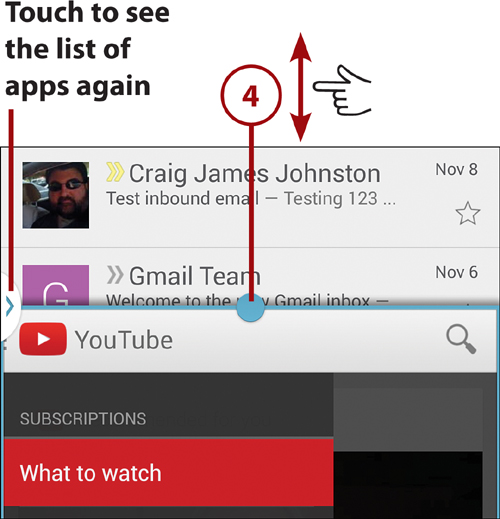
5. Touch the bar to reveal extra Multi Window features.
6. Touch to see all apps in the current window (if you have more than one).
7. Touch to swap the position of the apps on the screen.
8. Touch to enable dragging content between windows (like text or images).
9. Touch to close the selected window.

More Than One App in Each Window
You can have more than one app in each window. If you do have more than one and want to switch between them, touch the blue dot that is between the two windows, and touch the app selector icon (as shown in step 6). Then touch the app you want to switch to.

Installing Synchronization Software
Because your Galaxy Note 3 is tightly integrated with Google and its services, all media that you purchase on your phone is stored in the Google cloud and accessible anywhere, anytime. However, you might have a lot of music on your computer and need to copy that to your Google cloud. To do that, you need to install the Google Music Manager software or the Android File Transfer app for your Mac to copy any file back and forth.
Install Android File Transfer (Apple Mac OS X)
You only need the Android File Transfer app when using a Samsung Android phone (like your Galaxy Note 3) on an Apple Mac running OS X.
1. From your Mac, browse to http://www.android.com/filetransfer/ and download the Android File Transfer app.
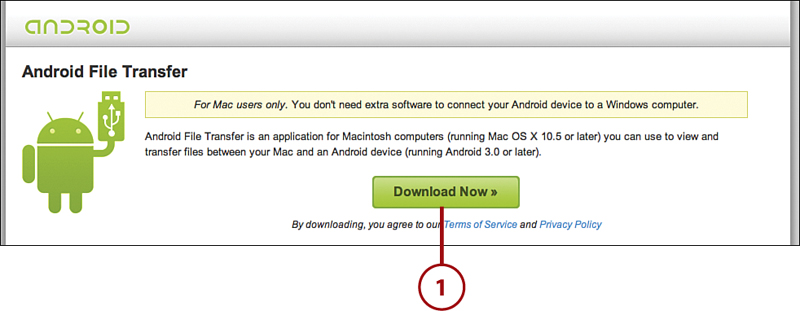
2. Click the Downloads icon.
3. Double-click the app in your Safari Downloads.

4. Drag the green Android to the Applications shortcut to install the app.
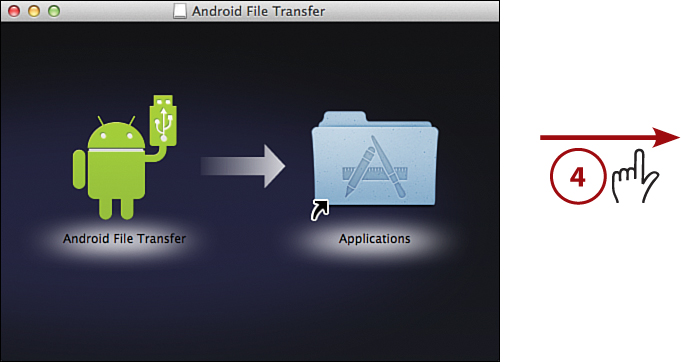
Install Google Music Manager (Apple Mac)
Don’t install Google Music Manager unless you plan to upload files from your computer to the Google Music cloud.
1. Visit https://music.google.com/music/listen#manager_pl from your desktop web browser and log in to your Google account if you’re prompted.
2. Click to download Music Manager.

3. Click the Downloads icon.
4. Double-click the app in your Safari Downloads.
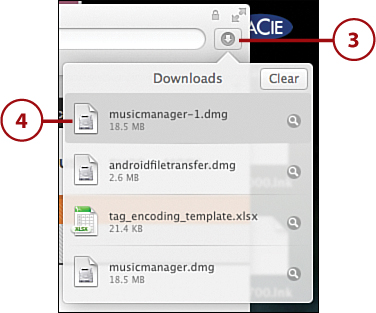
5. Drag the Music Manager icon to the Applications shortcut to install the app.
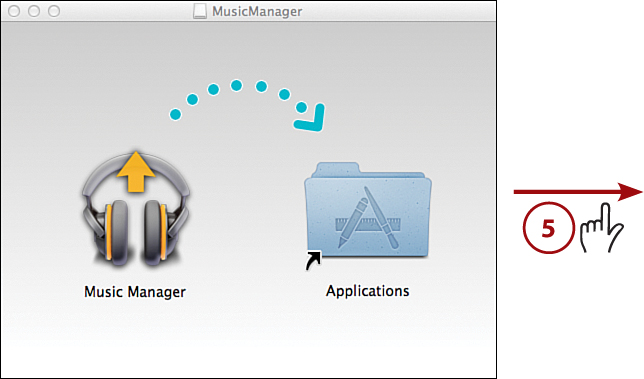
6. Double-click the Music Manager icon in the Applications folder.

7. Skip to the “Configure Music Manager” section to complete the installation.
Install Google Music Manager (Windows)
Don’t install Google Music Manager unless you plan to upload files from your computer to the Google Music cloud.
1. Visit https://music.google.com/music/listen#manager_pl from your desktop web browser and log in to your Google account if you’re prompted.
2. Click to download Music Manager.

3. Double-click the app in your Downloads folder.
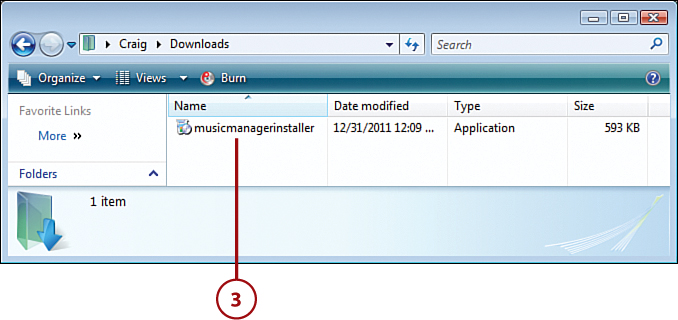
4. Skip to the “Configure Music Manager” section to complete the installation.
Configure Music Manager (Windows and Apple Mac)
1. Click Continue.

2. Enter your Google (Gmail) email address.
3. Enter your Google (Gmail) password.
4. Click Continue.
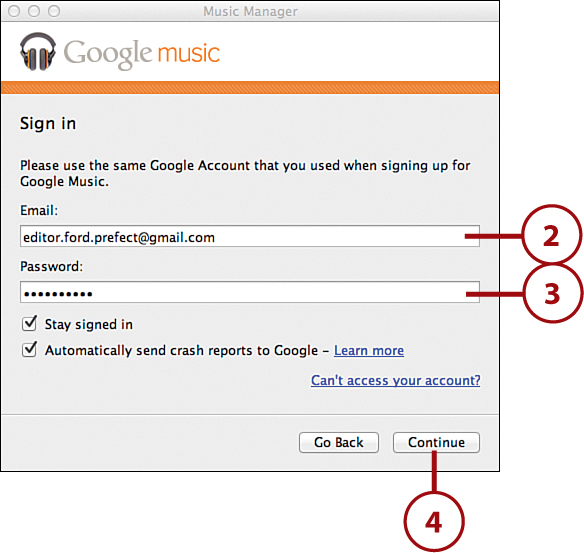
5. Choose where you keep your music.
6. Click Continue.

7. Choose whether to upload all of your music or just some of your playlists. Remember that you can only upload 20,000 songs for free. Skip to step 12 if you chose to upload all music.
8. Check if you want to also upload podcasts.
9. Click Continue.

10. Select one or more music playlists.
11. Click Continue.
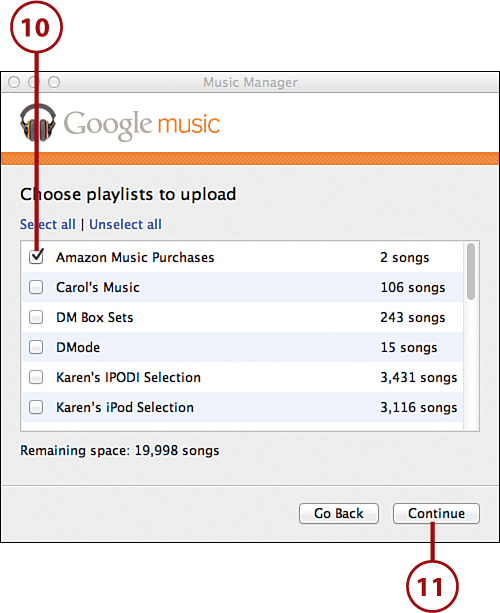
12. Choose whether you want to automatically upload any new music that is added to your computer.


14. Click Close.
